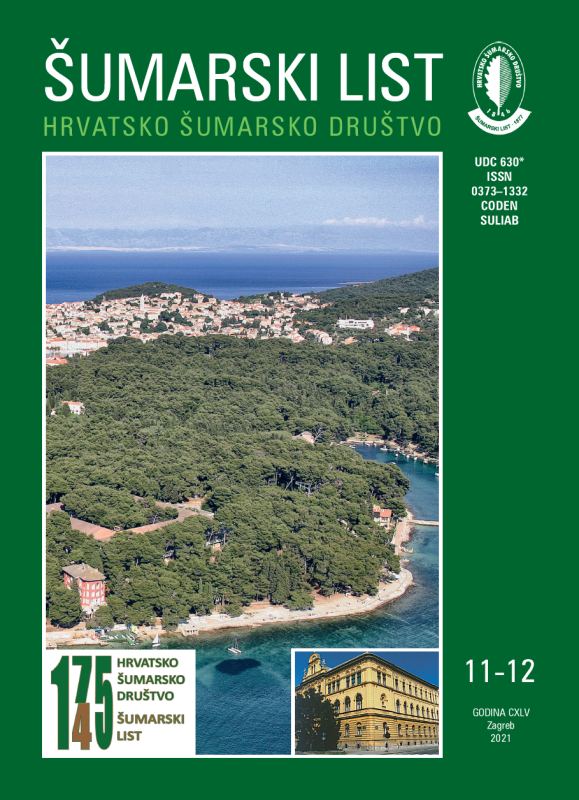
broj: 11-12/2021
pdf (11,5 MB) |
|
||||||||||||||
| RIJEČ UREDNIŠTVA | ||
| Uredništvo | ||
| What does the Glasgow Conference bring us? pdf HR EN | 513 | |
| IZVORNI ZNANSTVENI ČLANCI | ||
| David Mijoč, Nikola Perković, Mario Šporčić, Matija Landekić, Matija Bakarić, Andreja Đuka, Tomislav Poršinsky | UDK 630*360 +761 https://doi.org/10.31298/sl.145.11-12.1 | |
| Evaluation of the method of calculating the planned price of timber harvesting operations pdf HR EN | 515 | |
| T. Gomerčić, I. Topličanec, V. Slijepčević, S. Blašković, I. Selanec, I. Budinski, J. Tomaić, J. Kusak, Gj. Ivanov, M. Sindičić | UDK 630* 152 + 146 (001) https://doi.org/10.31298/sl.145.11-12.2 | |
| Distribution and minimum population size of Eurasian lynx (Lynx lynx) in Croatia in the period 2018–2020 pdf HR EN | 525 | |
| Summary Scientific data on distribution and abundance of endangered species are the foundation for their effective conservation and management. In this paper, we present results of the first scientifically – based estimation of lynx population size in Croatia. The goal of the study was to determine the area of lynx distribution and to estimate the minimum size of lynx population in Croatia in the period 2018 - 2020. To determine lynx distribution, 902 signs of lynx presence were collected in the period from the beginning of May 2018 until the end of April 2020. Out of those, 92.8% of lynx observations were categorized as C1, 2.8% as C2 and 4.4% as C3. Permanent lynx presence was confirmed in Primorsko – Goranska and Ličko – Senjska county, in southern part of Karlovac county and north-eastern part of Zadar county on the total surface of 7200 km2. For the minimum population size estimation, 804 camera trap photographs led to identification of 89 – 108 adult lynxes. Among 108 identified individuals there were 29 females, 22 males, while for 7 animals the sex was not determined. During the two reproductive seasons, we photographed 44 cubs in 25 litters. Future important steps in lynx population monitoring are correcting the deficiencies identified in this study and implementation of methodology that will allow us to use spatial capture recapture models for estimation of lynx abundance in Croatia. Key words: distribution; abundance; Lynx lynx; minimum population size; Croatia | ||
| Lovre Panđa, Ante Šiljeg, Ivan Marić, Fran Domazetović, Silvija Šiljeg, Rina Milošević | UDK 630*174.7 https://doi.org/10.31298/sl.145.11-12.3 | |
| Comparison of GEOBIA classification algorithms based on Worldview-3 imagery in the extraction of coastal coniferous forest pdf HR EN | 535 | |
| Marina Milović, Verica Vasić, Milan Drekić, Branislav Kovačević, Saša Pekeč, Zoran Galić, Saša Orlović | UDK 630* 181.3 + 164 (001) https://doi.org/10.31298/sl.145.11-12.4 | |
| Diversity of ectomycorrhizal fungi associated with Quercus petraea in the national park Fruška gora in the Republic of Serbia pdf HR EN | 547 | |
| Zafer Yücesan, Derya Bayram | UDK 630* 232.3 (001) https://doi.org/10.31298/sl.145.11-12.5 | |
| Effects of pretreatment, sowing time, sowing environment and climate factors on germination in Acer pseudoplatanus L. pdf HR EN | 557 | |
| PRETHODNO PRIOPĆENJE | ||
| Ivan Balenović, Luka Jurjević, Krunoslav Indir, Ante Seletković | UDK 630* 587 + 622 https://doi.org/10.31298/sl.145.11-12.6 | |
| Photogrammetric estimates of stand volume in pedunculate oak stands of the Pokupsko basin pdf HR EN | 567 | |
| Branislav Drašković, Marko Gutalj, Stefan Stjepanović, Boban Miletić | UDK 630* 233 https://doi.org/10.31298/sl.145.11-12.7 | |
| Estimating recent forest losses in Bosnia and Herzegovina by using the Copernicus and Corine land cover databases pdf HR EN | 581 | |


